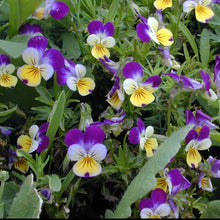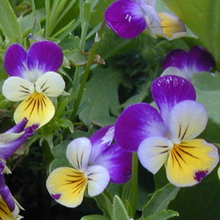With a multitude of vivid and cheery flowers, Johnny Jump-Up thrives in cool, sunny or partly shady locations. The small flowers are bright tricolor shades of purple, yellow, and white. Native to Europe, these are the original wild pansies and spread easily by self sowing. They are more heat tolerant than pansies.
Pretty in the front of a mixed border or as an edging along walkways. Johnny Jump-Up is great in containers too, where it makes the perfect companion for Sweet Alyssum Carpet of Snow (Lobularia maritima). Flowers have a light scent.
Available in single packets and as bulk wildflower seeds.
Also see this helpful information:
|
Live seeds per ounce (approx 28 grams):
|
18,700
|
|
Seeding rate per ounce:
|
550 square feet
|
|
Regions:
|
Throughout U.S. Does not like hot weather.
|
|
Native To:
|
Europe
|
|
Life Cycle:
|
Reseeding Annual or Perennial
|
|
Exposure:
|
Full sun / Partial shade
|
|
Height (inches):
|
6 to 12 in.
|
|
Bloom Period:
|
Spring, Summer (if not too hot) and Winter (in mild climates)
|
|
Flower Color(s):
|
Tricolor flower of purple, yellow, & white
|
|
Germination Period:
|
Cover seeds as darkness aids germination. |
|
Water Requirements:
|
Needs regular watering
|
| Wildlife: | Attracts butterflies |
|
Cultural Information:
|
Easy to grow. Often reseeds itself.
Requires soil that drains well. In mild climates, plant in the fall for winter/spring bloom. In cold climates, start early indoors or sow in spring for early summer flowers. Thin plants so they are 6 to 8 inches apart.
Fertilize as needed with a low nitrogen fertilizer. |
| Links to additional information and photos: | Establishment and Care of Wildflowers |
|
|
|




